Summer is the time for so many outdoor art activities in New York, and perhaps one of the most popular destinations in the city is the High Line, the former train tracks that were turned into a public park in Chelsea and the Meatpacking District. The Art Newspaper had the opportunity to walk the line with Cecilia Alemani the organisation’s curator and director of High Line Art, to see how the summer was treating this year’s sculptures, part of which comprise the current group show Wanderlust. Join us for a director’s tour of the elevated art park.
The tour began at the northern opening of the High Line, near its newest section, where there is no art and the High Line curves around the Hudson Yards project. “We don’t water it,” Alemani said, of the vegetation in this section, “we don’t tend to it, so it’s actually exactly what you would’ve seen if you came here in the 1990s, because the High Line was abandoned in the 80s for two decades.” Other parts of the park are more manicured.

“We have a lot of art on view. Every year we have a group exhibition that’s between 8 and 12 artists that respond to the High Line with new works. This year, the show is called Wanderlust, and it’s about the act of walking and exploring and journeys,” Alemani said. “This is one of the first artworks; it’s a subtle little work. You see this long rail? It’s by an Italian artist named Giorgio Andreotta Calò. This piece is inspired by Mildred Lisette Norman, the Peace Pilgrim, and she walked across the United States more than 20 times. You know Forrest Gump? The same thing happened to her, she started being followed by people. You’ll see 16 of these metal rods, each has the name of this person and how much they walked, how many miles. The length of the rod corresponds to how many miles, so this is the longest one.”
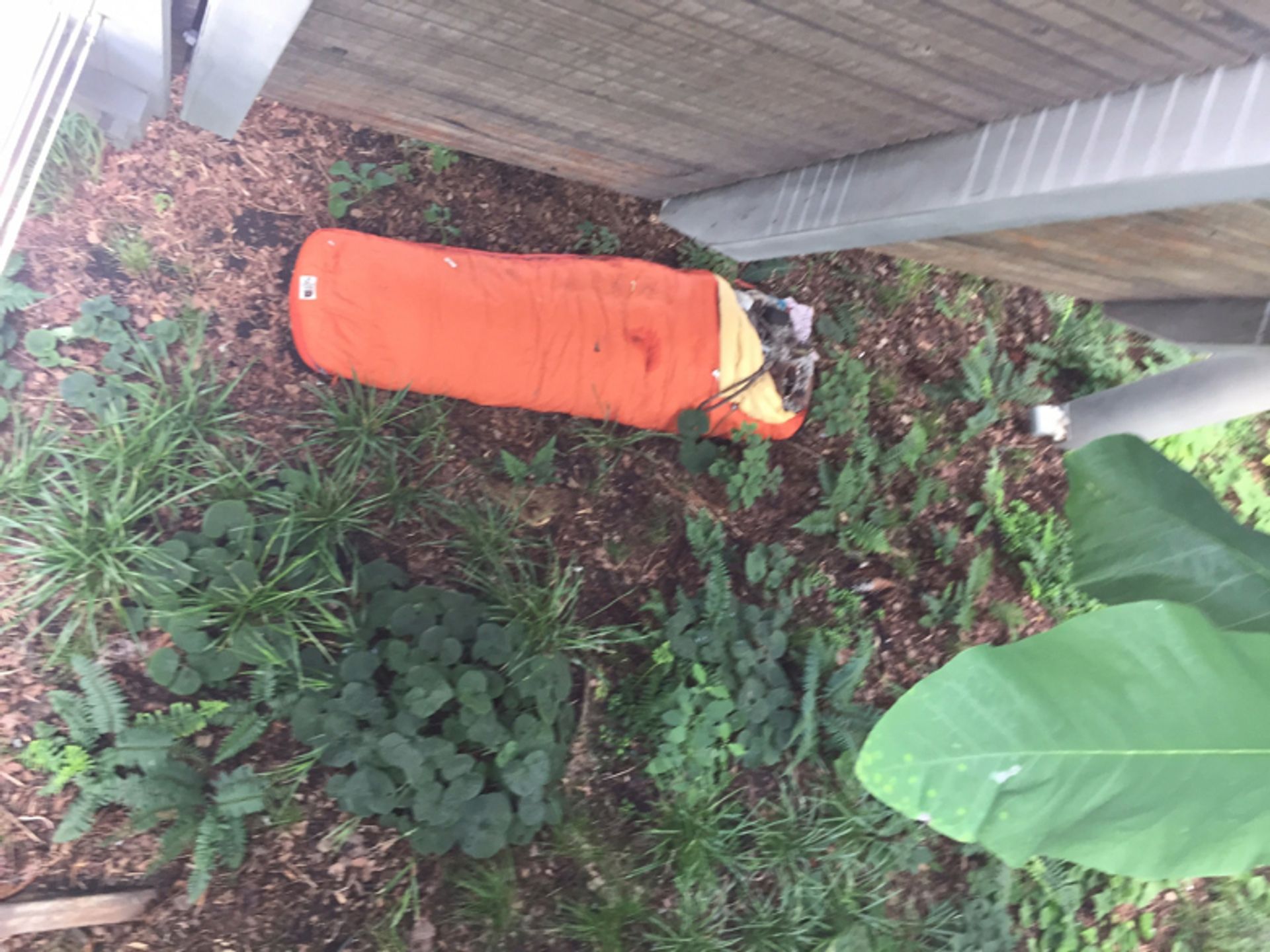
“This is a piece by Mike Nelson. In his practice he hikes and walks a lot. He’s spent a lot of time in the wilderness in the UK, so he fills these sleeping bags with remains of debris from the construction sites next to the High Line. It’s interesting to me because I can see remains of previous artworks in them, that’s part of the Adrián Villar Rojas installation. It’s funny because we get calls all the time saying: someone is living in the High Line!”
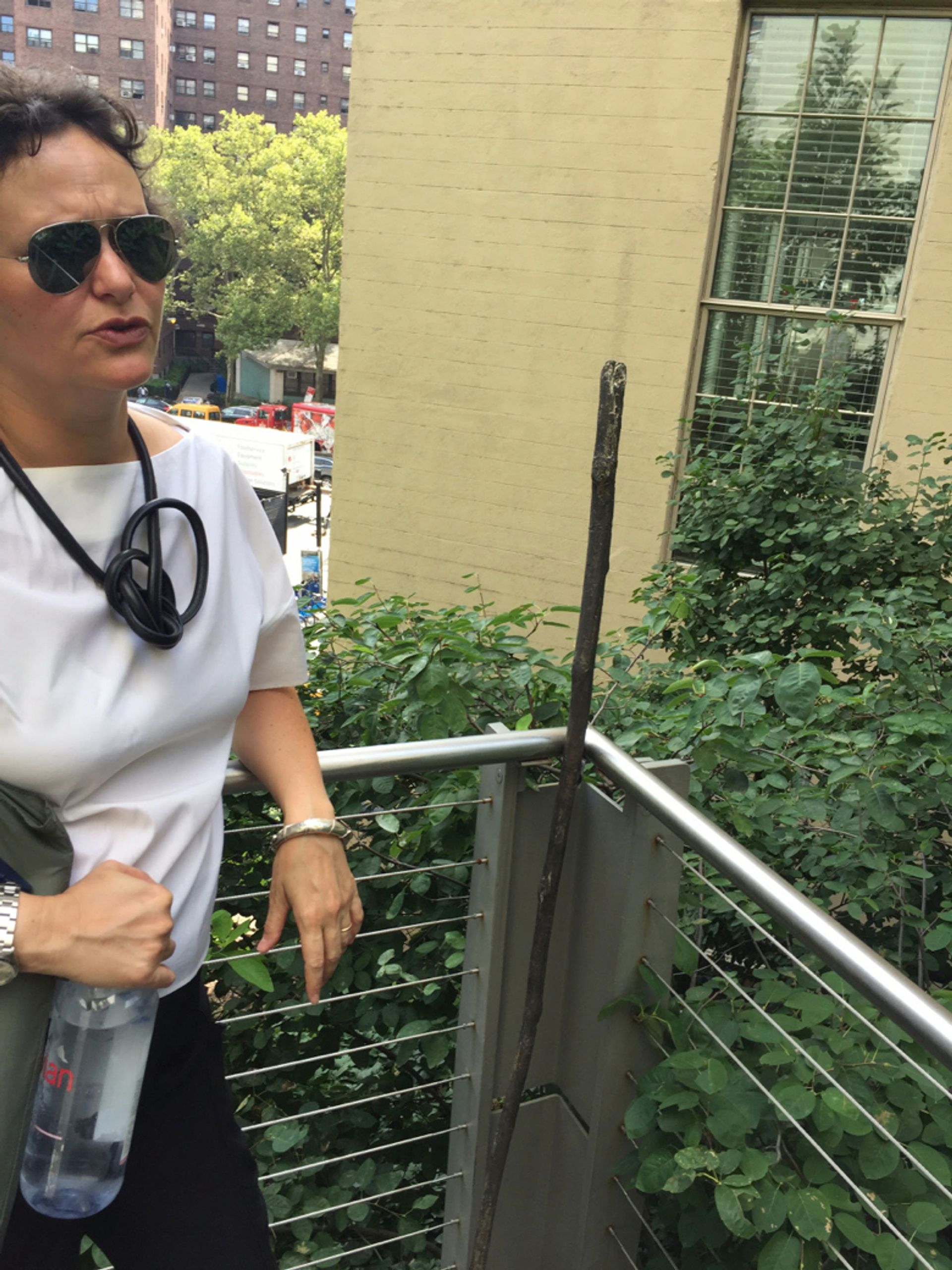
“This is another piece by Giorgio Andreotta Calò. It’s a cast of his walking stick. He’s from Venice and he would walk to Amsterdam carrying this stick. This is a bronze casting and we also have a copy of it made an aluminum that you could take on your walks on the High Line. If you want to, just go to the office and give your ID and you can take it with you on your journey.”
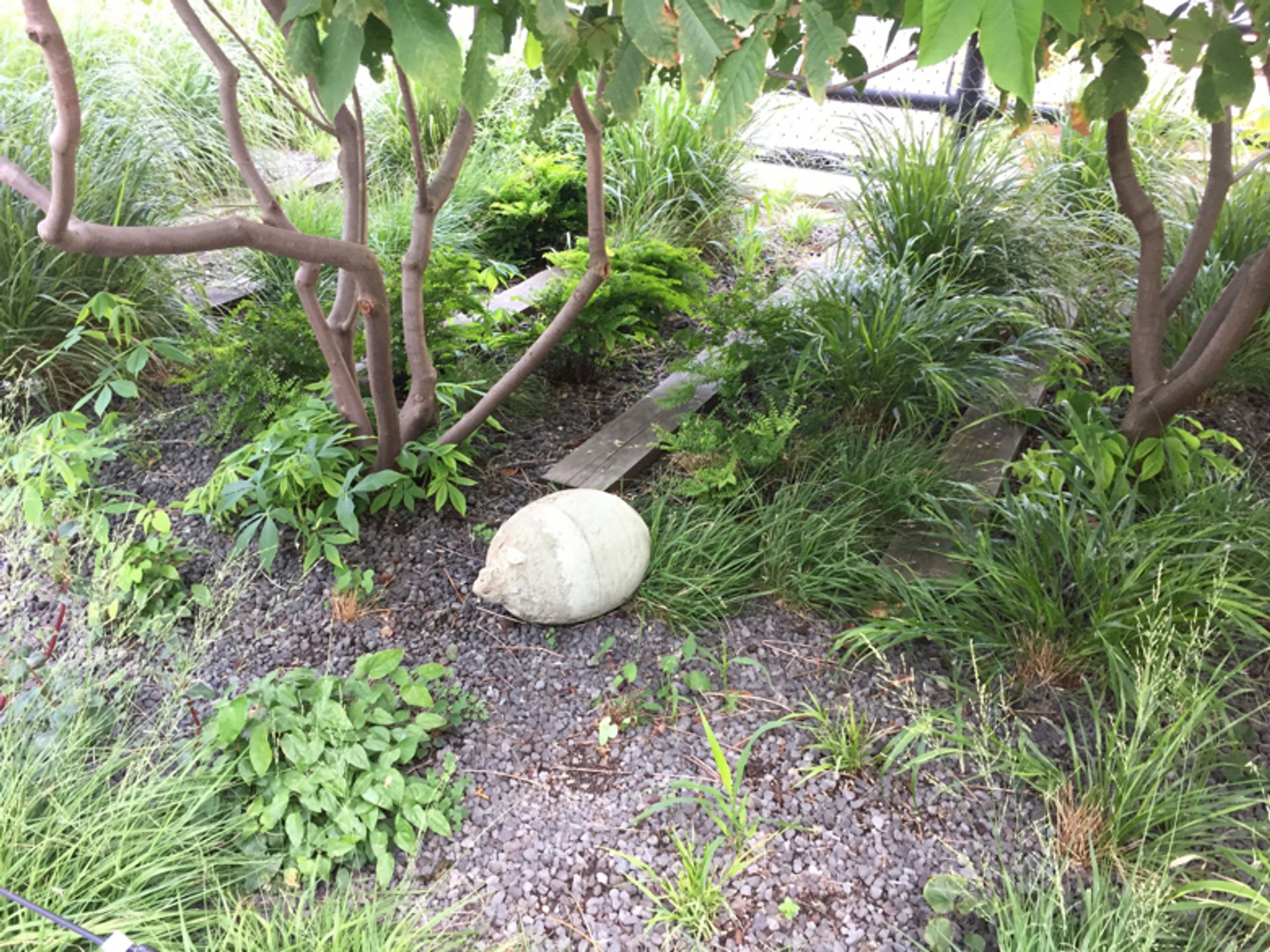
“This is work in progress by a young artist from Brazil named Paulo Nazareth. It’s a series of concrete watermelons in the grasslands. The story goes that he was interested in the story of Brasília. Apparently when Oscar Niemeyer built the city, he used a cement factory that was known for employing unpaid people and the most iconic architectural symbols of Brasília were built by people that were not paid. [Nazareth] wanted to take the watermelon, a very symbolic fruit, from Africa, to the Americas and cast it in concrete. He’s currently traveling from Georgia to New York, following all the Underground Railroad routes and dropping off more watermelons all over America and he’s going to get here and drop off some more watermelons on-site. He is kind of a character; he doesn’t have email or phone so we don’t really know where he is. He’s just going to come to the office one day and say, ‘Hey, I got like 1,000 watermelons to drop off on the High Line.’”
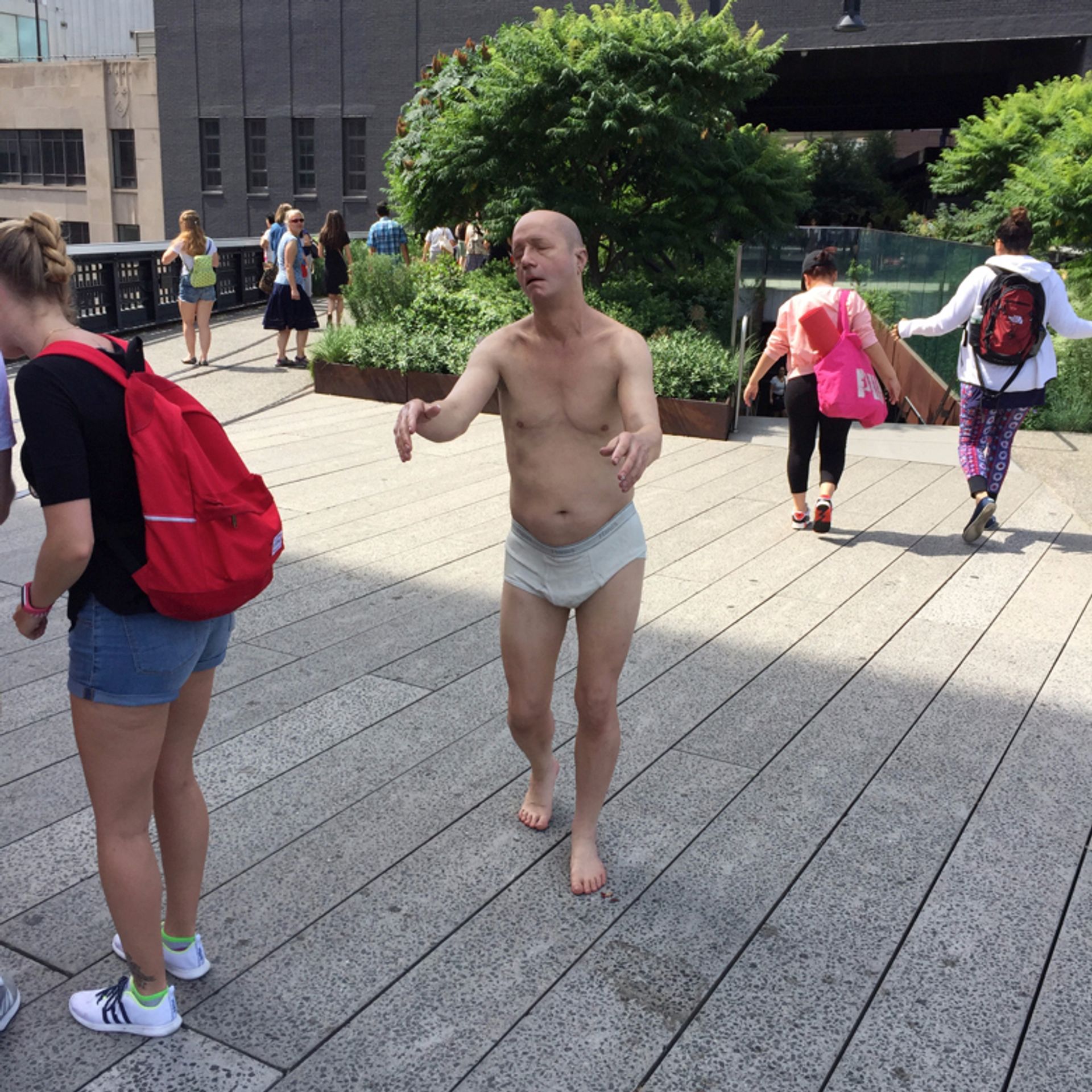
“Every year there is one piece the people go crazy for, and this year it’s Sleepwalker by Toni Matelli,” Alemani said of the hyper-realistic sculpture of a somnambulant man. The work was previously installed on a college campus but was removed after complaints from students. “That’s the opposite reaction to what happened at the High Line. Do a hashtag search for ‘sleepwalker’ on Instagram, you’ll see. To me it’s an amazing artwork. It’s made of bronze. Look at the details, I love the sock line on his feet. It’s actually really, really well made.”

“This is a giant piece by Rayyane Tabet, but it’s actually been swallowed by vegetation. It’s okay, he loves it. It’s 37 rings that go back all the way to 18th Street, part of an ongoing project he’s been doing. It’s a reference to a gas pipeline that an American company built in 1948 to bring gas from the Persian Gulf to the Mediterranean. It was used for a few decades but in the 1990s it was abandoned and because it’s an aboveground pipeline it’s probably the only physical object that traverses countries that are now at war with each other. The diameter is exactly the same as the real one. Each ring has a GPS coordinate engraved in the top. You know we installed this in April when there is nothing on the High Line, not even a weed. This is what happens. Nature takes over and the artist has to be flexible enough to accept and embrace it. When it was installed, it was very polished; the rings are now starting to rust. When we see them again in October they will be surrounded maybe by brown plants and in December with snow. The idea is that, for people who live in New York, you could come back and see them always looking very different.”

“This is not part of the group show. It’s one of the independent commissions by Kathryn Andrews. She wanted to think of one of the many things that you do in the park on the High Line, so one of the many leisure activities is sunbathing. This is actually a photo of a real sign that is out on Sandy Hook, you know that the little island off of New Jersey that is a nudist beach. Of course, we don’t allow nudity on the High Line. What happens is that every four minutes there are seven misters that spray water in your face, so it’s refreshing in the summer and kind of funny, but every sculpture will be here for 12 months, so in the winter it will assume yet another meaning. Do you see the water on the floor?”
“The first week, we saw someone over there,” Alemani added, pointing behind sign. “She was completely naked and some people got really upset.”
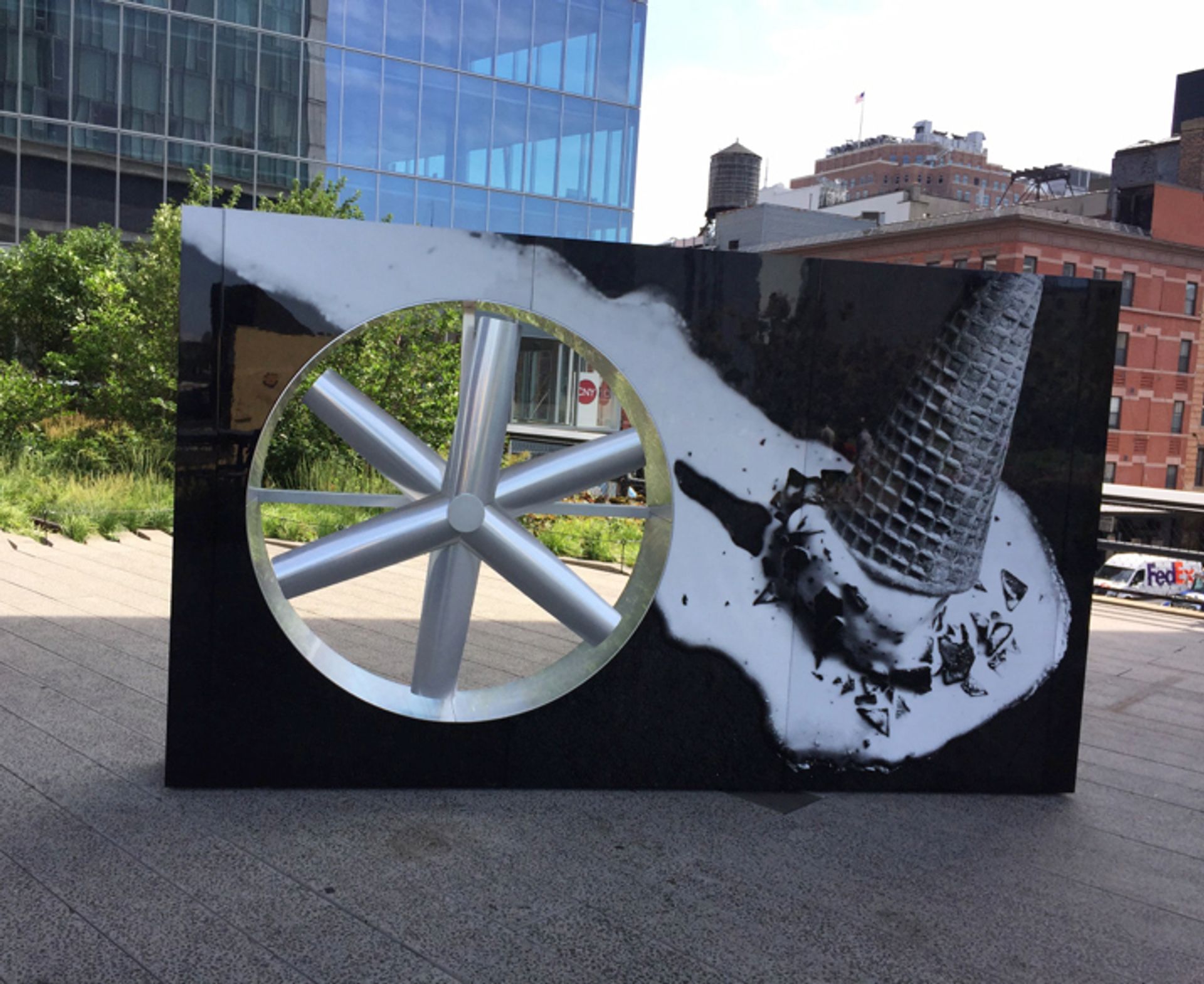
“This is the second half of the Kathryn Andrews piece and once again it refers to one of the many activities that you do on the High Line in the summer, the ice cream cone. And the fan. This is the windiest location of the High Line, it’s a crazy wind tunnel no matter what day of the year, it is always so windy. She wanted to refer to that, though the fan itself is of course motorised.”
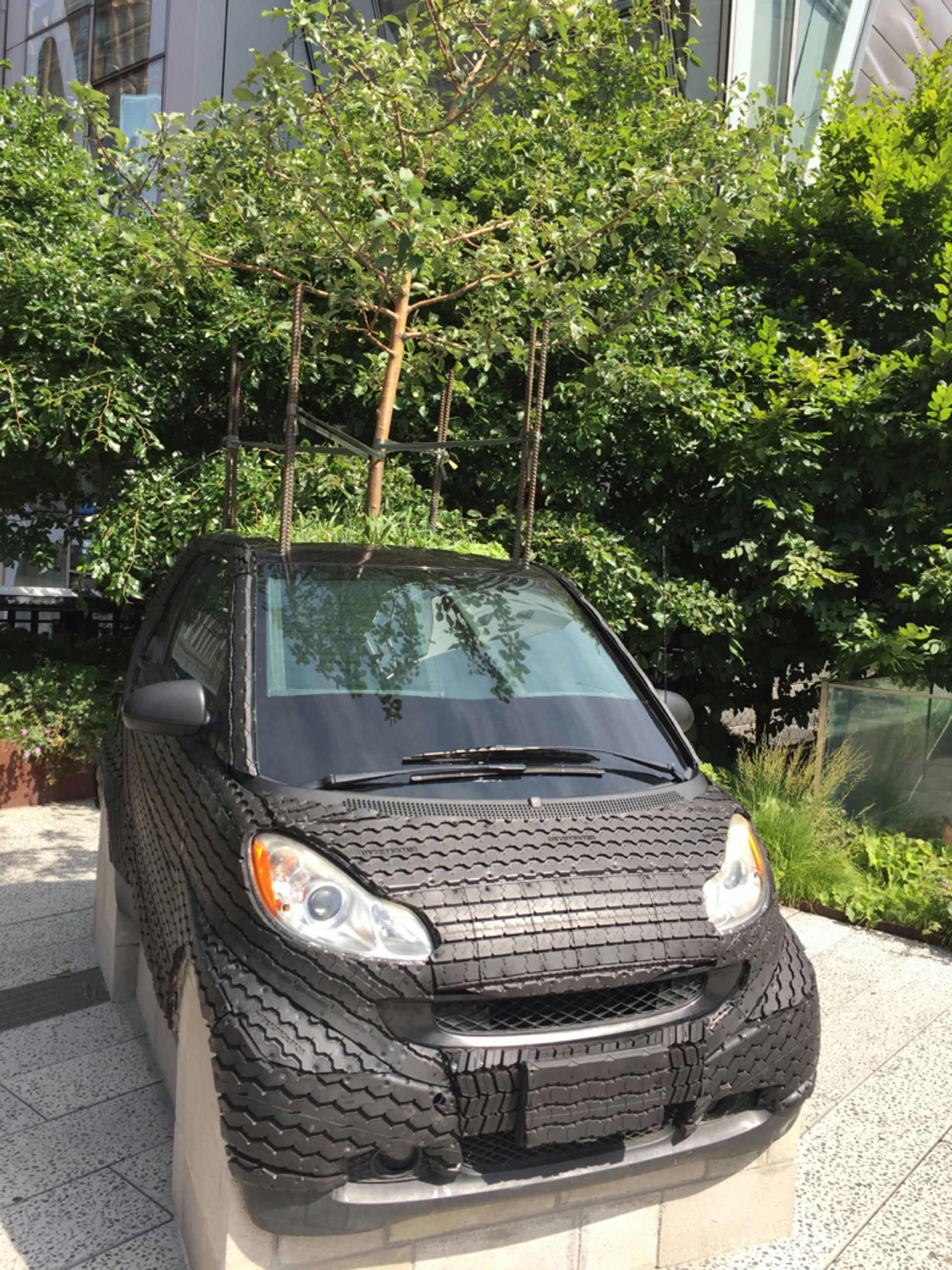
Another new commission that is not part of the group show is Nari Ward's Smart Tree. “It was triggered by a childhood memory from back in Jamaica. His father couldn’t afford to buy his own car so he would buy broken cars with the idea of fixing them one day and keep them in the family yard and never actually fix them. When Nari moved to New York in the late 1980s, and went back to Jamaica for the first time in 15 years, he found a lime tree sprouting from within the cars. He wanted to replicate that memory. This is a Smart Car that has been covered with tire treads to indicate speed, but also the wheels have been replaced with cinderblocks and rebar, to reference buildings that have not been finished, which is iconic in the Caribbean. It’s a big vase basically. The solar panels power the light at night and make the water go through the system.”
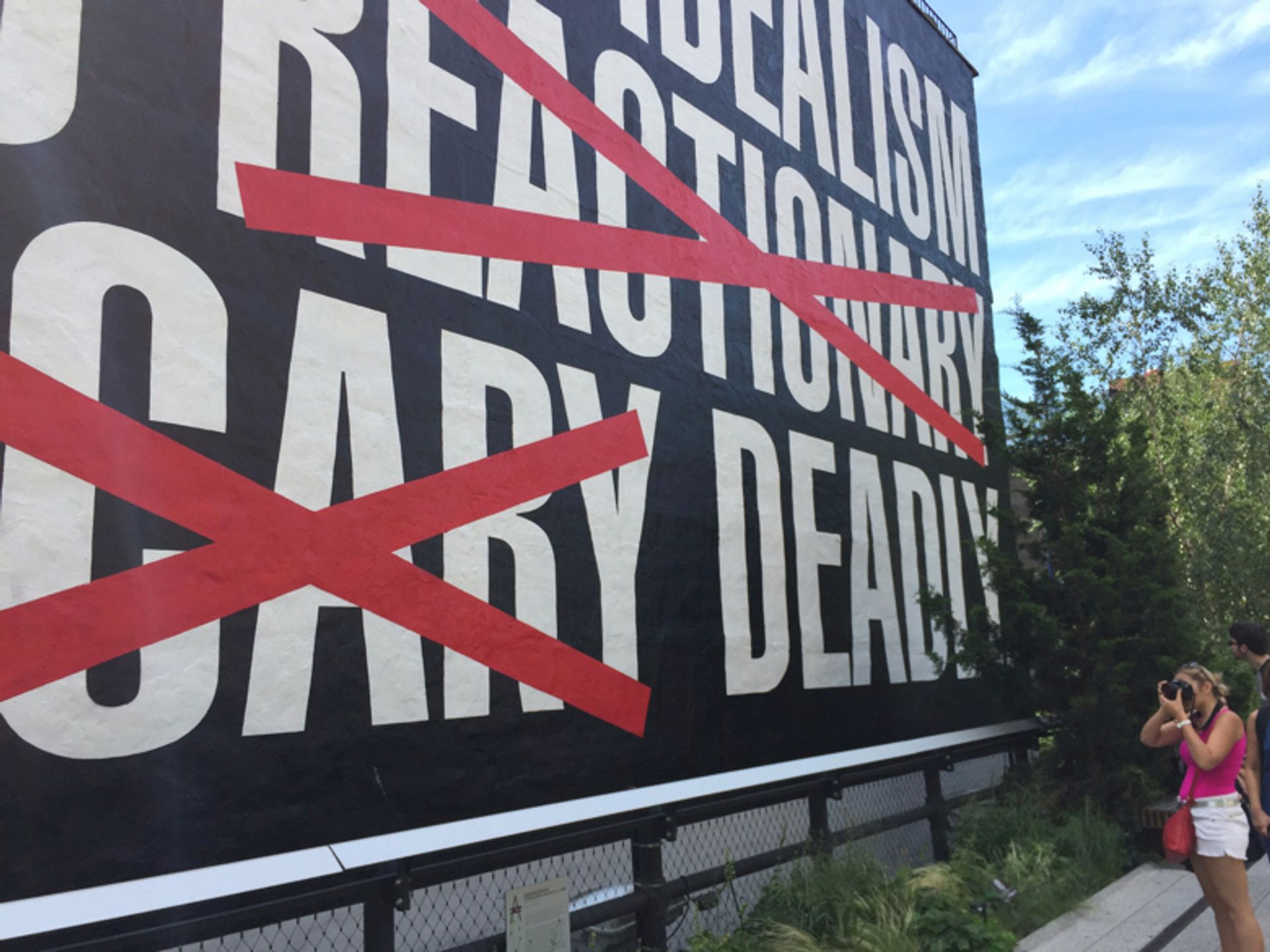
Also outside of the group show is Barbara Kruger's Untitled (Blind Idealism Is…). “We have a deal with the owner of this building and he lets us use this wall every year. We had a work by Ed Ruscha a few years ago and one by Kerry James Marshall last year. This is of course by Barbara Kruger. We tend to work with a lot of sculptors and installation-based artists on the High Line and this is an opportunity to work with more conceptual artists or painters or photographers, mediums that it’s really hard to integrate here.”

“This is another piece lost in nature, by the Los Angeles-based artist Matt Johnson. It is an actual track from the High Line. He wanted to render it as a doodle, a scribble he did on a piece of paper. We said okay, then we brought it to a foundry and they created this sort of three-dimensional drawing in space, which sounds really easy but it’s really, really complicated. When it was installed, there was nothing here but now it’s completely eaten up by the vegetation.”
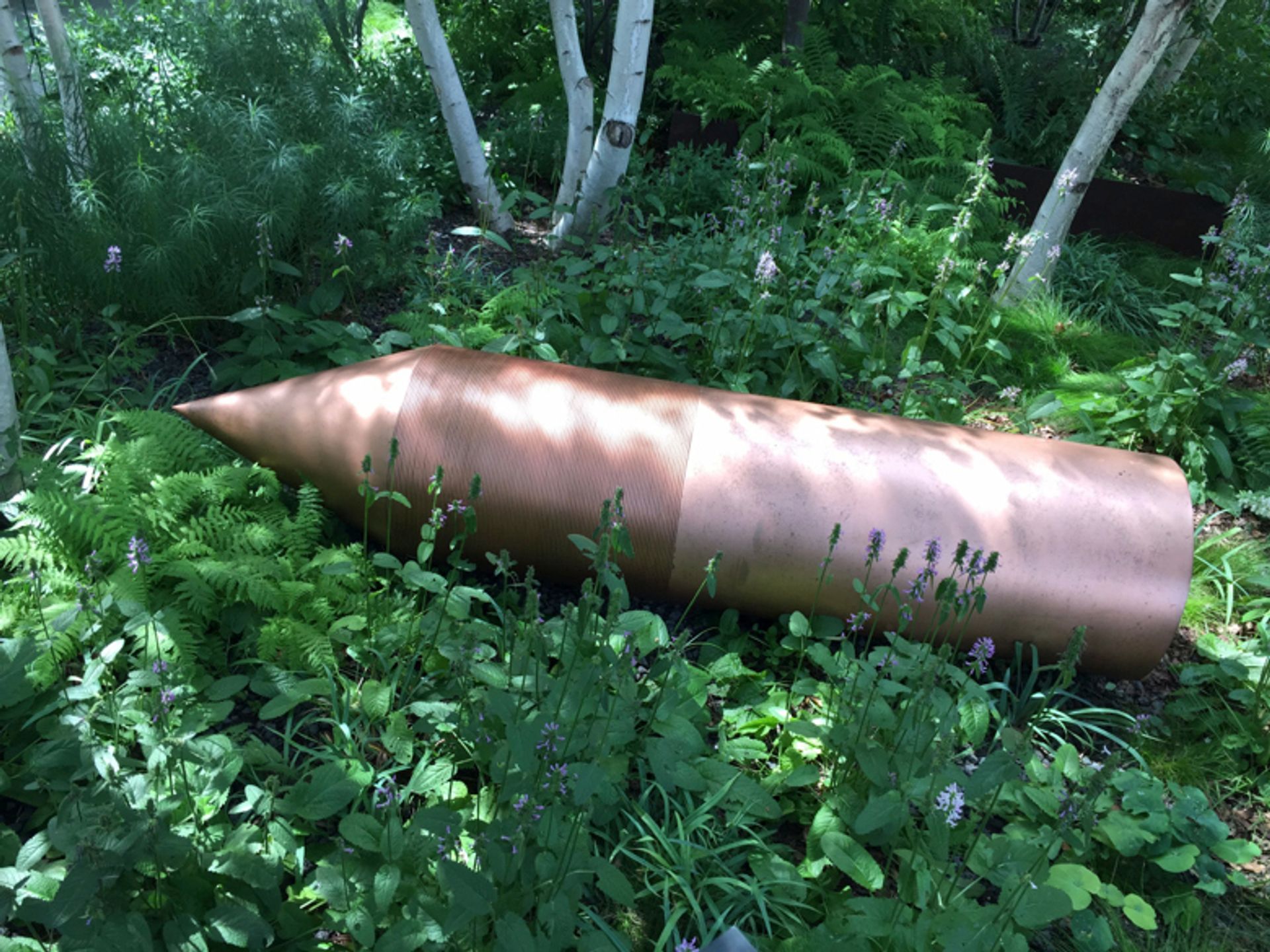
“Iman Issa’s work suggests the history of monuments and architectural features. She creates these abstract sculptures that refer to specific architectural features but she also creates the signs that go with the piece to tell you exactly what it is. It’s like an archaeological or traditional museum sign that makes you think about the power of display and museological tactics.”
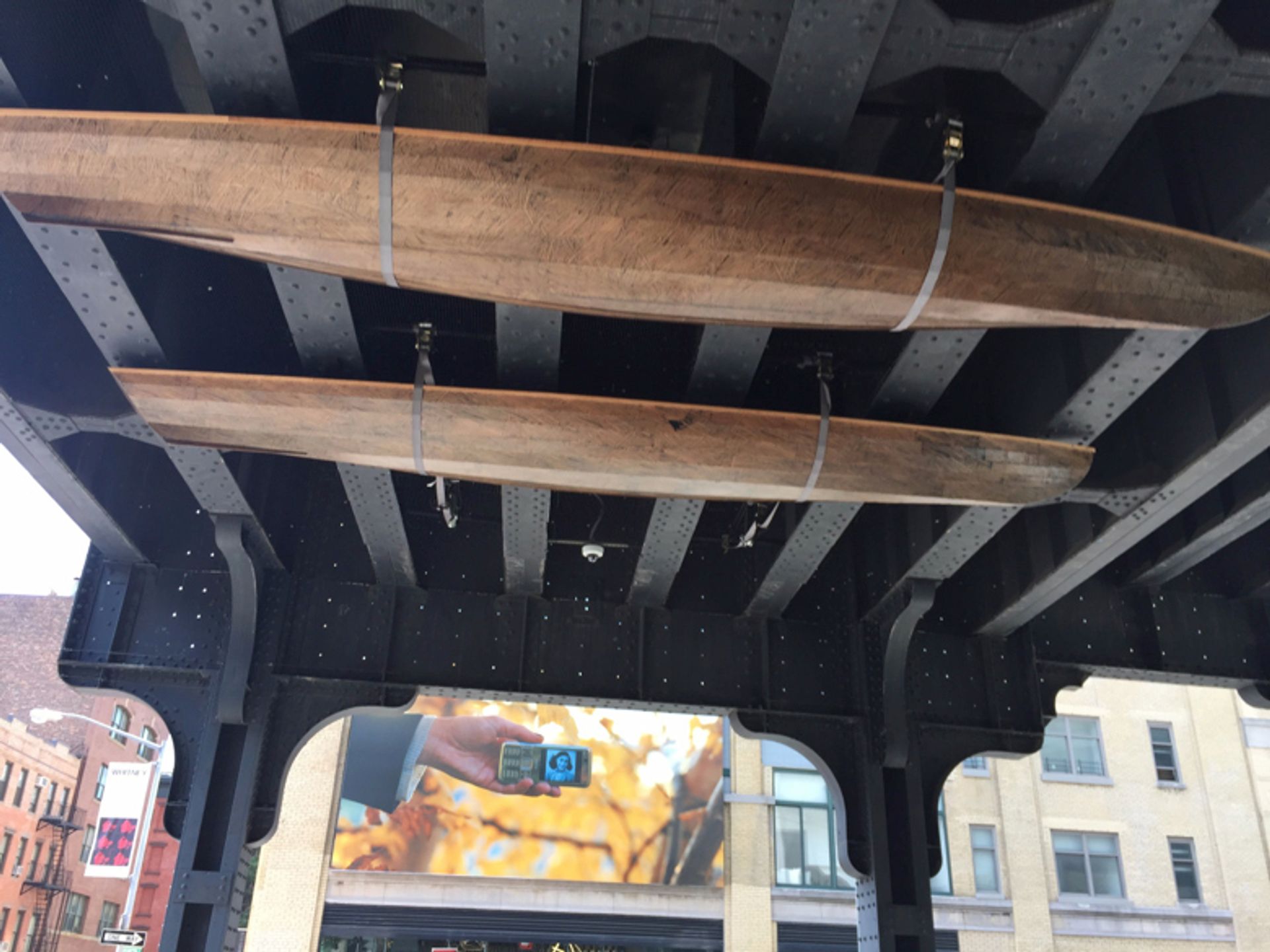
“Marie Lorenz has handmade boats and canoes and she takes friends and acquaintances around the city of New York in the waters to have a different perspective on the city. This is actually three boats. There’s a sculptural element but once a month we lower them into the water. We take them into the Hudson River and we take people for rides down the Hudson River up near Pier 40 and it’s amazing because you can go out among the old piers and you have completely different perspective on New York from the water. They’re really low and the Hudson is really rough so it’s a unique experience. Right now, she is doing a resistance project upstream. She is riding down from Buffalo to here, she'll get back around 11 August.”
“I think that’s it!”

